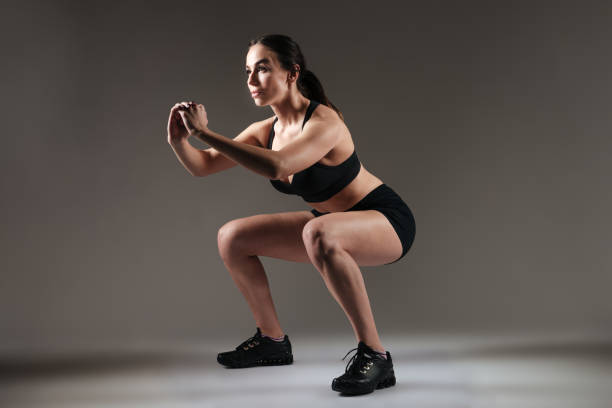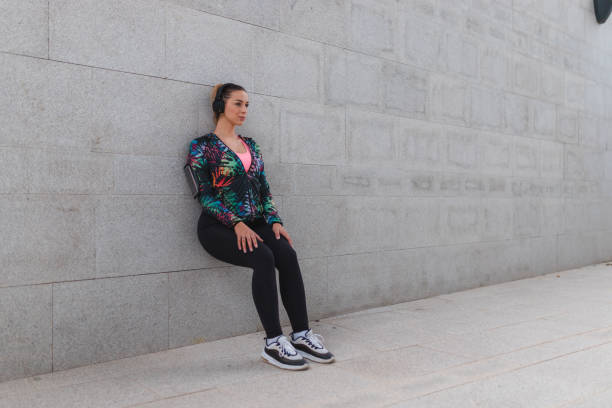
Squats are a fundamental exercise for building strength in the core tight lower body. However, squats can be tricky if you have weak or injured knees. This is why it’s important to have strong knees to do squats properly and avoid injury. In this blog, we’ll discuss the knee anatomy, the importance of having solid knees for squats, the best knee-strengthening exercises, and how squats can help strengthen knee.
Anatomy of the Knee
The knee joint is a complex structure of bones, cartilage, ligaments, tendons, and muscles. The thigh bone (femur), the shin bone (tibia), and the knee cap (patella) make up the bony structure of the knee. The cartilage provides cushioning between the bones and helps absorb shock when we move. The ligaments and tendons connect the bones to muscles and help to stabilize the knee joint. The muscles of the thigh (quadriceps) and the back of the leg (hamstrings) also play a role in knee stability. These structures work together to allow movement and support the body’s weight.

Importance of Strong Knees for Squats
Strong knees are essential for performing squats because the exercise puts a lot of stress on the knee joint. Weak knees can lead to poor form, pain, and, in the worst case, injury. When the muscles surrounding the knee are strong, they can better support the knee joint and improve stability. Strong muscles around the knee also help distribute the weight more evenly, reducing the stress on the knee joint. Therefore, it’s crucial to work on knee-strengthening exercises to perform squats properly and reap all the benefits of the exercise.
Best Knee-Strengthening Exercises
Several exercises can help strengthen the knee joint. These include leg extensions, leg curls, calf raises, and lunges. Leg extensions are done by extending your knees against resistance in a seated position. Leg and other leg curls involve curling the lower leg towards the buttocks in a seated or lying position. Calf raises are performed by standing on the balls of your feet and lifting your heels up and down. Lunges are a great exercise for the entire lower body, including the knee joint.
Squats for Knee Strengthening
Squats are among the most effective exercises for the lower body, including the knee joint. They work the thighs, hips, and buttock muscles, providing a full-body workout. Squats also help improve knee stability by developing the surrounding thigh muscles well. However, it’s essential to perform them correctly to avoid injury. Keep your knees behind your toes and chest and shoulders up when squatting. Start with bodyweight squats and gradually add weights as you get stronger.
Thigh and Hip Strengthening Seated Leg Raises
One of the most effective knee-strengthening exercises is the thigh and calf muscles and hip-strengthening seated leg raise. This exercise targets your thighs, hips, and core muscles, essential for knee health and stability. To perform this exercise:
- Sit on a chair with your back straight and your feet flat on the floor.
- Slowly lift one leg off the floor and raise it until it is level with your hip.
- Hold for a few seconds, then lower your leg back down.
- Repeat on the other side.
- Aim for 10-15 repetitions on each leg for 2-3 sets.
Hamstring stretch with thigh contraction
Another excellent exercise for strengthening your knees is the hamstring stretch with thigh contraction. This exercise targets your hamstrings, which are important for knee flexibility, and your quadriceps, abdominal muscles which help support the knee joint. To perform this exercise:
- Lie flat on your back with your legs straight.
- Bend one knee and bring it up towards your chest.
- Hold your ankle with both hands and slowly straighten your leg until your foot faces the ceiling.
- Hold for a few seconds, then slowly lower your leg to the ground.
- Repeat on the other side.
- Aim for 10-15 repetitions on each leg for 2-3 sets.

Benefits of strengthening the muscles around the knees
Strengthening the muscles around your knees can benefit your overall health and wellness. Strong knee muscles help improve knee stability, flexibility, and range of motion, which can help prevent knee injuries and pain. Building stronger knee muscles can prevent knee pain and also improve your balance and posture, reducing your risk of falls and other injuries. Additionally, strong knee muscles are essential for athletes and fitness enthusiasts who engage in activities that stress the knees, such as running, jumping, and squatting.
When to Seek Help for Knee Pain
If you are experiencing knee pain or discomfort, knowing when to seek help from a healthcare professional is important. Some signs you may need to see a doctor for knee pain include persistent pain, swelling, and stiffness. If you cannot bear weight on your knee or have difficulty moving it, you should seek medical attention immediately. Other signs that may indicate a more severe knee injury or condition include popping sounds or sensations, instability, and visible deformity. If you are unsure whether your knee pain is serious, it is always better to err on the side of caution and consult with a healthcare professional.
Knee bends:
Knee bends are a classic knee-strengthening exercise that targets the quadriceps muscles in your thighs. Start a knee bend by standing upright with your feet shoulder-width apart and your arms extended forward. Slowly bend your knees, lowering your buttocks towards the ground until your thighs parallel the floor. Hold this position for a few seconds, then stand up straight again. Repeat for 10-15 reps, rest for a minute, and do another set. If you find this exercise too easy, you can hold weights in your hands or do it on an unstable surface like a foam pad.
Standing hamstring stretch:
The hamstring muscles at the back of strengthen your knees and thighs are often neglected but play a crucial role in knee stability and mobility. To perform this stretch:
- Stand in front of a chair with your feet hip-width apart.
- Place your right foot on the chair with your heel touching the edge and your toes pointing up.
- Straighten your left leg and lean forward, keeping your back straight and your hands on your thighs. You should feel a stretch in the back of your right thigh.
- Hold for 30 seconds, then switch sides.
- Repeat for 2-3 sets on each leg.
Single leg squat:
Single-leg squats are a challenging exercise that works multiple muscles in your legs and hips while improving your balance and coordination. Start by standing on your right leg with your left leg lifted and your hands on your hips. Slowly bend your right knee, lowering your body towards the ground while keeping your left leg straight and your left foot lifted. Ensure your right knee doesn’t go past your toes and your body stays upright. Pause for a few seconds, then return to the starting position. Repeat for 10-15 reps, then switch sides. You can hold onto a wall or a chair if you need more support.

Wall sits:
Wall sits build endurance and strength in your quadriceps and gluteal muscles. Find a wall and stand with your back against it. Walk your feet forward until they are about hip-width apart, and your knees are bent at a 90-degree angle. Rest and stand with your feet and arms at your sides or thighs, ensuring your back stays flat against the wall. Hold this position for as long as possible, trying to reach at least 30 seconds. Rest for a minute, then repeat for 2-3 sets. You can hold a weight or a medicine ball in your hands to make this exercise harder.
Split Squat, Monster Walk (Side Steps), Squat to Lateral Leg Raise, Lateral Lunge
These four exercises are all great for targeting the muscles in the knee area. The split squat, for example, is highly effective at targeting your quadriceps and glutes. On the other hand, the monster walk or side steps emphasizes your gluteal muscles and your abductors, adductors, and lower leg muscles. Squatting with lateral leg raises is an excellent exercise for targeting the quadriceps and glutes. Finally, the lateral lunge emphasizes your glutes and adductors. All these exercises are great for improving mobility and strength in your knees, and glute muscles which is why you should perform them as much as possible.
Banded Glute Bridge
The Banded Glute Bridge exercise is perfect for targeting your glutes while encouraging better hip movement. To perform the banded glute bridge exercise, you must get a resistance band and then wrap it tightly around your thighs, just above your knees. Next, lie on the floor, with your knees bent and feet planted firmly on the ground. Keep your arms by your sides, and slowly lift your hips off and parallel to the floor or ground, squeezing your glutes as you do so. Hold this position for a few seconds, then slowly lower yourself. Repeat the exercise for a few sets at a time, and gradually increase your number of repetitions to get the best results.

Lunge Hold
The Lunge Hold exercise is also perfect for targeting the muscles in the left knee and area. To do a lunge hold exercise:
- Start in a lunge position with one foot in front of the other and your back leg bent at the knee.
- Ensure that your front knee is aligned with your ankle and that your core is engaged.
- Hold this position for as long as possible, ensuring your knees align with your ankle.
- Repeat the exercise for a few sets and gradually increase your repetitions. You can perform this exercise anywhere, any time, in the gym or at home.
Conclusion:
In conclusion, these three exercises are perfect for targeting the muscles in the knee area. They also help improve mobility and strength while avoiding or minimizing knee problems. If you have been dealing with knee problems, here is your chance to get them sorted before they become significant. Consistency is the key, and remember to give your muscles time to recover between exercises. Strengthening your muscles now could not only alleviate your knee pain but may also prevent future knee injuries. So, go ahead and give these knee exercises now a try and say goodbye to knee problems.


Leave a Reply